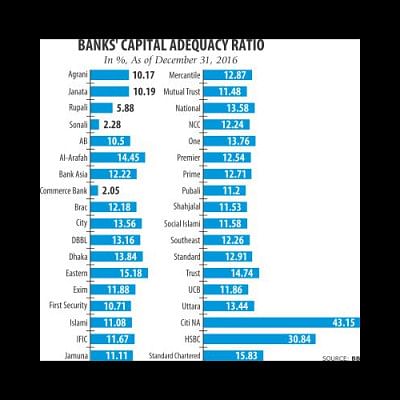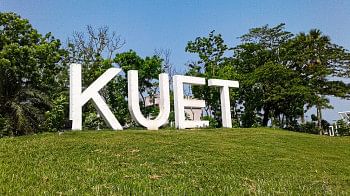Banks' capital swells

Overall capital of banks rose 7.81 percent in the last quarter of 2016, but 11 banks failed to maintain the capital in line with the new international standards.
As per the Basel III framework, the state banks are in capital shortfall with Sonali, BASIC and Bangladesh Krishi Bank or BKB on top of the list.
Eleven out of 57 banks failed to maintain minimum capital. Rupali, Janata, Agrani, Rajshahi Krishi Unnayan Bank, Bangladesh Commerce Bank, Farmers Bank, AB Bank and ICB Islamic Bank are among them.
Most of the private and foreign commercial banks succeeded in the field.
The central bank last year took steps to improve banks' financial health by increasing their CRAR in line with Basel III standards, introduced in January.
Basel III is a comprehensive set of reform measures, developed by the Basel Committee on Banking Supervision, to strengthen regulation and supervision and reduce risks of the banking sector globally.
On December 31 last year, the total capital in the banking system was Tk 83,758 crore, up from Tk 77,687 crore on September 30 of the same year, according to Bangladesh Bank.
Premier and First Security Bank failed to maintain the capital adequacy ratio in the third quarter of last year; but in the last quarter they succeeded.
Some of the banks are suffering from a huge capital shortfall because of high defaults.
BKB has a shortfall of Tk 7,083 crore, Rakub Tk 742 crore, BASIC Tk 2,684 crore, Sonali Tk 3,475 crore and Rupali Tk 714 crore.
The government plans to meet the capital deficit of these banks through bonds instead of cash.
On December 31 last year, the banks' average capital to risk weighted assets ratio or CRAR was 10.80 percent. This was 10.31 percent three months ago.
CRAR is a measure of a bank's capital and is used to protect depositors and promote the stability and efficiency of financial systems around the world.
Last year, the central bank decided to implement the Basel III framework and conducted a quantitative impact study.
On the basis of the study, they also sent a roadmap to the banks on how they would implement the framework.
In four quarters from January 2016, the BB evaluated the banks' capital adequacy as per the Basel III standards.
Until December 31, 2015, the banks had to maintain their capital adequacy ratio at 10 percent of risk-weighted credit exposures. From 2016 to 2019, the banks will have to maintain their capital at 0.625 percent in addition to 10 percent as their CRAR.
In the last quarter of 2016, the CRAR of the private banks rose by 0.53 percentage points to 12.36 percent.
In the same period, the ratio increased by 1.22 percentage points to 25.37 percent for foreign banks. For the state banks, it was 5.86 percent on December 31 last year, a 0.24 percentage-point increase from the previous quarter.

 For all latest news, follow The Daily Star's Google News channel.
For all latest news, follow The Daily Star's Google News channel. 



Comments